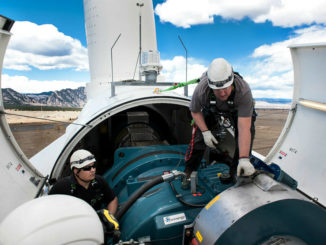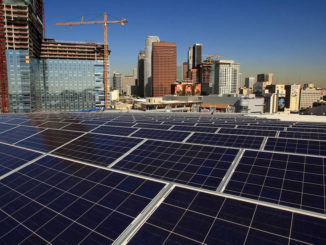
CITYLAB OCT 17, 2018
In light of even more dire news about our warming planet, leading thinkers tell us the one thing cities and states could do to cut emissions significantly—and fast.
A landmark report released by the U.N. last week has laid out the stakes of a warming planet more starkly than ever. Warming of just 1.5 degrees Celsius could bring on the most severe consequences of climate change, according to the Intergovernmental Panel on Climate Change (IPCC) report.
Many cities and states are leading the public charge to address this, particularly in the U.S. after President Donald Trump pulled out of the Paris climate accord. But it’s not yet clear what their tangible and collective impact has been.
So we asked some leading thinkers on local action and the environment: What is one thing a city or state could do to cut emissions significantly, fast?
Focus on transit and transportation
Annise Parker
former Mayor of Houston and president & CEO of LGBTQ Victory Fund
Transit and transportation systems are significant contributors to greenhouse-gas emissions. There are immediate regulatory and organizational changes possible, to be followed by intermediate and long-term initiatives. Immediate actions: Cities have regulated tailpipe emissions, limited idling, and created car-free zones. They have eliminated subsidized parking for privately-owned vehicles and restricted parking availability for businesses.
Longer-term, cities can optimize, expand, and align transit and transportation systems with an understanding of future technology trends. An example is Houston reconfiguring its bus system, which led to better service and ridership, as well as feeding its light rail system. Another is working with trucking firms to better route trucks to and from the Port of Houston.
Create ‘go zones’
Shelley Poticha
managing director, Healthy People & Thriving Communities Program, Natural Resources Defense Council
We have built giant energy-wasting buildings, produced millions of tons of methane-producing garbage and waste, relied on a carbon economy, and failed to prioritize infrastructure that helps mitigate extreme storms and temperatures. As a result, cities and local jurisdictions know they are now facing crises on a number of fronts—from climate change to affordable housing—and that their very survival as centers of commerce, community, innovation, and vitality is at stake. The IPCC report only makes that more clear.
But if cities consume more than two-thirds of the world’s energy and account for over 70 percent of carbon emissions globally, they are also key to the climate change solution. Immediate steps by cities to make themselves more sustainable and resilient are possible, and many are already acting: committing to renewable energy, setting emissions targets, and pledging to stick to the Paris climate agreement goals.
A surgical strike by cities to cut emissions would be to quickly introduce and pass a supply-and-demand payment system for using congested roads. London, Singapore, Milan, and Stockholm have all had success with such programs. When Stockholm introduced congestion pricing in January 2006, traffic to the city center dropped by 20 percent literally overnight. London had a similar improvement. Stockholm also reported a 47-percent drop in child asthma and the pricing model produced a revenue stream that pays for transit and walking infrastructure.
Some U.S. cities are ready to jump on board with this commonsense approach that not only reduces pollution but helps people get places at a fair cost in a reasonable amount of time. As we’ve learned since we were sold the idea that cars were a ticket to freedom, driving isn’t free, and it isn’t easy when we pay the price in deadly pollution and choking traffic.
This is but one response that can be undertaken to address the urgency of climate change. At the local level, doing so is complex and takes an understanding that many approaches are interrelated, but there is much that can be done—and be done immediately, so that we can give our cities back to people again.
Take pressure off the central business district
Vishaan Chakrabarti
Founder of Practice for Architecture & Urbanism (PAU) and author of A Country of Cities
One big action that cities can take in the face of climate change is to rethink what and where a central business district is in the 21st century. Urbanites and rail-based suburbanites tend to have lower carbon footprints due to their use of mass transit and smaller dwellings. But as our cities have grown they have become a hot mess, with unaffordable housing and office space dominating most downtowns. Technology can shift that dynamic, both because tech companies are seeking interesting locations outside of traditional business districts, and because the technology of mobility is changing with the advent of e-bikes, scooters, zero-emission buses, and an age-old biped technology called walking.
Cities should embrace this transformation through zoning, tax, and transportation policies in order to shift pressure from overtaxed central business districts to other interesting and more affordable urban neighborhoods where people can live, play, and work. By encouraging these new workplaces off the beaten path—often in old historic warehouses or in distinctive new architecture—residents can have shorter commutes in walking or biking distance from their existing communities, helping to save both their pocketbooks and the planet.
Mandate clean energy
Jameson McBride
energy and climate analyst, the Breakthrough Institute
At the Breakthrough Institute, we’re excited to see real action on an ambitious state policy idea: clean-energy standards. They’re simple legal mandates for a certain share of a state’s electricity to come from carbon-free sources by a certain year. For example, in the clean-energy standard signed into law recently in California, the state mandated 100 percent clean energy by 2045. Arguably the best part of these policies is their flexibility. Utilities can meet the mandate with any mix of zero-carbon technologies, including wind, water, solar, nuclear, and even fossil fuels with carbon capture. Many studies (here’s one) have shown that a mix of low-carbon power technologies will provide the fastest, cheapest, and most politically likely path to decarbonizing our electricity. Clean-energy standards enable states to set really ambitious climate goals that are also achievable—while supporting emerging technologies that will be needed for climate progress.
Require buildings to be carbon-zero
Emma Stewart
director of Urban Efficiency & Climate, WRI Ross Center for Sustainable Cities
Cities represent roughly 70 to 75 percent of global emissions. Upgrading homes to greater energy efficiency and enticing residents into transit or more efficient vehicles are the best ways cities can make a meaningful impact. If I had to pick only one, the evidence shows that the greatest opportunity lies in deep improvements to the energy demanded by buildings, where Westerners spend 90 percent of our time and which are leaking both carbon and money.
Setting a target for zero-carbon building construction by a certain date accomplishes multiple objectives. It A) tackles the greatest source of cost-effective urban emissions reductions (i.e. buildings), B) improves air quality and occupant experience, C) provides developers and owners a hedge against rising electricity (and in some places, carbon) prices, and D) transforms buildings into new and distributed sources of clean energy and storage, necessary to capitalizing on the full societal potential of electric vehicles. Win, win, win, win.
Source: https://www.citylab.com/environment/2018/10/local-climate-actions-biggest-impact/572608/
Visits: 43




Be the first to comment